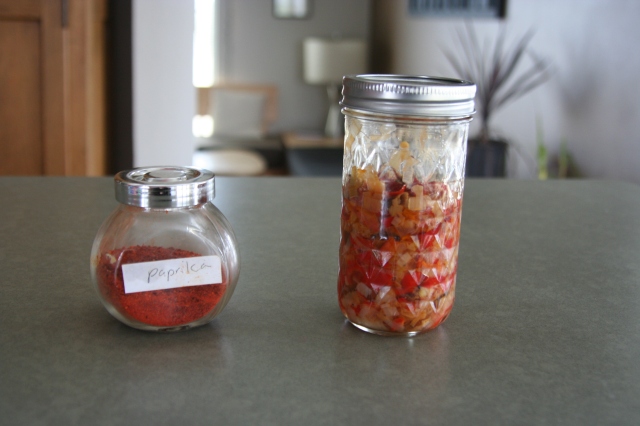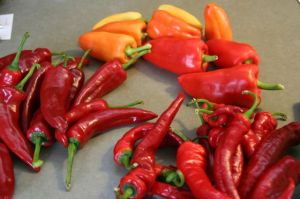 I am truly surprised to report that my favorite thing from the garden last year was peppers. I was pretty enamored by tomatillos, it is true. But now that I am getting to the end of the canned produce, what really stands out is the peppers.
I am truly surprised to report that my favorite thing from the garden last year was peppers. I was pretty enamored by tomatillos, it is true. But now that I am getting to the end of the canned produce, what really stands out is the peppers.
I truly felt panicked when it seemed like my pepper plants might not germinate. I cannot imagine a garden now without an entire bed of pepper plants.
What is odd about this is that if you were to ask me what foods I don’t like, at the top of the list would be peppers. Namely, green peppers. I don’t like ’em raw and I don’t like ’em cooked. But I don’t mean jalapeño or serrano peppers. Not poblano peppers. I don’t like those chunky, boxy green peppers that are ubiquitous in the supermarket and in lots and lots of American salads and dishes. I feel about them the way some people feel about cilantro– I don’t even like the smell of them.
 This is why I started slow in growing peppers. The first year, I must admit, I dried and froze a lot of poblanos and then didn’t know what to do with them. I’d planned on throwing them in stews and stuff, but I forgot. Because peppers aren’t really something that comes to mind when I’m cooking.
This is why I started slow in growing peppers. The first year, I must admit, I dried and froze a lot of poblanos and then didn’t know what to do with them. I’d planned on throwing them in stews and stuff, but I forgot. Because peppers aren’t really something that comes to mind when I’m cooking.
Luckily, the director of the retreat center gave me a jar of red pepper sauce for Christmas, and suggested using it like a pasta sauce. It was delicious, and I was determined to make this and other canned peppers. I also went ahead and dried and ground paprika.
Freshly ground, home-grown paprika is not like paprika from the store. Recipes these days are often very specific about the kind of paprika they want you to use: smoky, Hungarian, Spanish, sweet… I don’t have a pantry with several kinds of paprika. And I haven’t been disappointed with my home-ground paprika yet. I just took down the third long string of peppers and ground them for summer cooking.
Rather late in the year I discovered I could use the pepper sauce, and when that was gone my single jar of roasted peppers, and when that was gone this one jar of pepper-leek-olive tapenade, stuffed in chicken breasts with grated zucchini. I also used that pepper sauce as a base on pizzas. I don’t think I could make enough pepper sauce to satisfy me.
I have found peppers pretty easy to grow. They like heat, but they’re not fussy about water like tomatoes. So far I haven’t had any trouble with blight or other diseases. You don’t have to worry that you’re splashing them with hose water and if they get a little limp, water perks them right up. They do need staking, but not a full-blown structure with vines tied up everywhere like tomatoes.
This year, I’m going to make as much red pepper sauce as I can. I’m gonna string up the paprika peppers, too. I’m also going to grind up my red thai peppers for hot red pepper. Why do I keep buying cayenne?? A bottle of Tapatio hot sauce lasts me years, so I’m not feeling the need to make my own hot sauce yet. But you never know.



Here in South Florida our growing season is winding down. It gets too hot to grow much. This year I joined a CSA and enjoyed produce all winter, There is just 2 weeks left. I dried mint, cilantro. oregano, dill and celery leaves. I pickled a half pint of hot pepper rings for hot sauce. The organic celery is thin ribs with lots of wonderful leaves. Right now I have a bunch of yellow squash and Florida Sweet Onion. I found a nice recipe for sandwich relish here on WordPress. It is a small batch recipe that uses the squash and onion. I have 3 pint jars left that are empty and the recipe makes a pint and a half, so I will double it. I tried several new things this year. I enjoy doing this. By the time November rolls around I will be digging in the bottom of my freezer and opening the last few jars.
Thanks for the idea to dry peppers next year.
So you have a short season for the opposite reason that I do! Thanks for sharing about the produce that you get there in South Florida. Last year I planted something called “alfina cutting celery” that seemed to be just leaves! Which is fine with me, but I didn’t think to dry them. I will do that this year. CSAs are a great way to get good produce and support local farmers! I enjoy seeing all your quilt patterns and what you’re doing there.